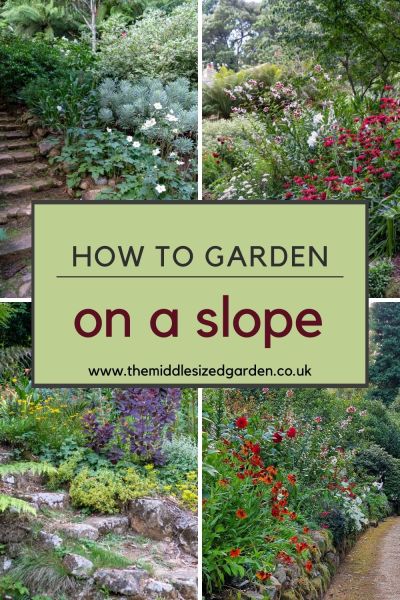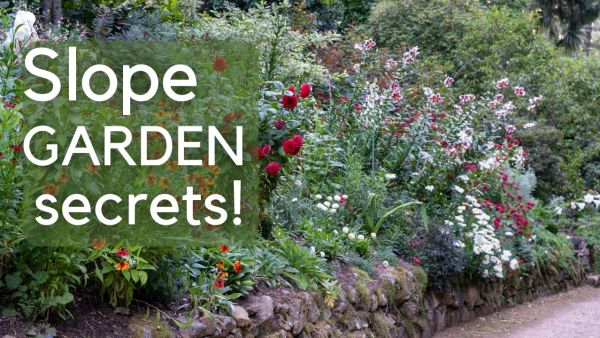Sloping garden solutions – the real truth about gardening successfully on a slope
Whether you have a steep, sloping garden or just a small bank, there are some key facts you need to know about gardening on a slope.
However, once you understand the principles, you’re not restricted to any particular ‘plants that are suitable for sloping gardens’. You can plant the plants you love.
So I talked to Richard and Lesley who have a large sloping garden on a steep mountain. What they told me applies to smaller gardens and even a relatively small change of level. The only difference is that if your garden is either smaller or less steep, then your gardening will probably be a little easier!
But there is no better source of reliable information than people who actually garden on a slope (rather than a round-up created by someone working in an office!).

Embrace your sloping garden
Lesley says that the first step is to ’embrace your inner mountain goat.’ By this, she means that gardening on a slope is different from gardening on the flat, and it’s important to accept that.
That applies to making changes, such as landscaping, and also to regular maintenance, such as planting and watering.
Although she was a highly experienced gardener, Lesley had never gardened on a slope before moving here seven years ago. So she had to accept that she needed to learn different strategies and techniques.
She says that you have two options. ‘One is to accept the slope and work with whatever gradient you have.’
The other is to create flat areas by creating terraces. This will mean engaging landscapers or doing some heavy duty landscaping yourself.
Lesley and Richard have combined both approaches, which is also another option.
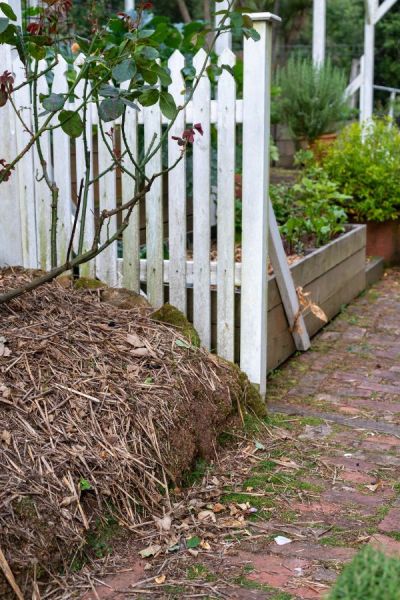
Sloping or terraced? Richard and Lesley have planted shrubs, such as roses, on the sloping land, but have created terraced raised beds for vegetable growing.
You see a sloping border from more angles
If your borders are flat, you can see them from the front. And if you have paths all around, you may also see them from the back or from either side.
But you see a sloping border from above and from below as well. That’s two potential extra perspectives.
‘So you need to think about those new angles when you’re planting.’ Lesley also thinks that these two extra perspectives are both the best side of having a sloping garden and the worst. ‘They’re wonderful things. And they’re also challenges. And it can mean you can get longer vistas in a sloping garden than you can in a flat garden.’
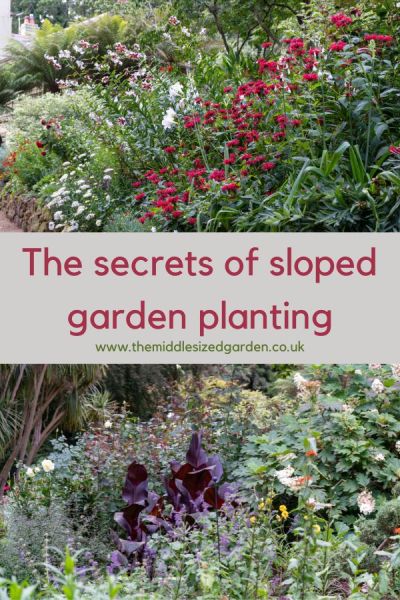
Two views of Richard and Lesley’s main sloping herbaceous border. The top photo shows the view looking upwards, while the other shows a view looking down at it from one side.
So don’t stick to the usual rules on plant heights
‘The traditional “tallest at the back, smallest at the front” way of planting doesn’t work in a sloping border,’ advises Lesley.
‘Sometimes you have to be brave and place a tall plant at the front or the side,’ she says.
The extra height means you can plant shorter plants further up the slope, in the middle of the border.
If you do plant smaller plants at the front, with taller ones at the back, the border can look as if the planting is slipping down the hill.
Lesley does plant some smaller plants in front, but they sit side by side with larger ones.
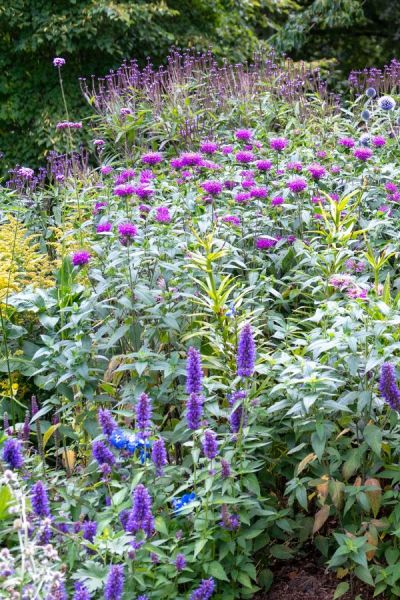
Which way does this border slope? In fact, there isn’t a huge height difference between the agastache, monarda and veronicastrum, but the shortest plants – the agastache – are actually at the top of the slope which is in the foreground. This border does actually slope down away from where the photo was taken!
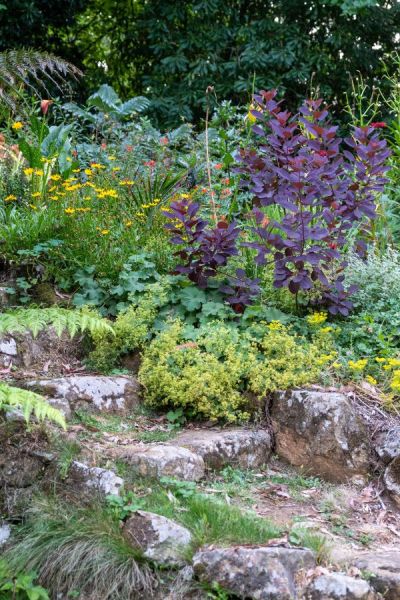
The steps are fringed with low-growing Alchemilla mollis but the Cotinus ‘Royal Purple’ behind is taller than the yellow rudbeckia further up the sloping border.
Start with one border
If you’re new to slope gardening, then Lesley suggests you get to know your garden gradually.
Lesley and Richard’s garden was created in Victorian times when the house was built, but had been very neglected over recent decades. There was a mass of old rhododendrons, the 19th century dry stone walls and lots of self-seeded weedy growth. ‘We decided to start with the garden nearest the house and work outwards,’ says Lesley.
The nearest border to the house is also the main herbaceous border. Lesley says she learned so much about slope gardening by trying to get one border right. ‘I was prepared both to take things out or move things around if they weren’t working.’
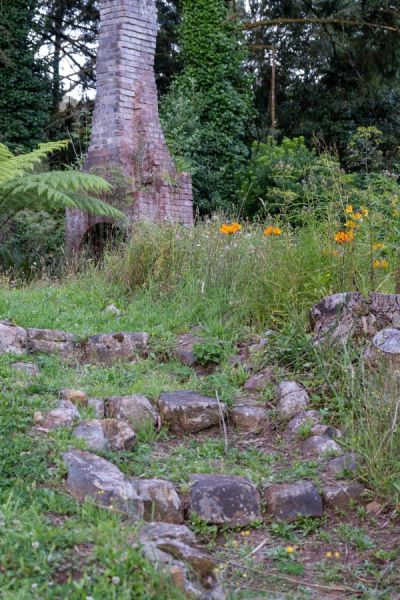
Many parts of the garden were almost wild when Richard and Lesley moved in. Even after 7 years, there are still a few areas that they haven’t yet decided what to do with.
Does the slope face to or away from the sun?
It’s important to work out whether you have a sunny slope or a shady one.
‘Phototropism – plants leaning out towards the light – is worse in sloping gardens,’ says Lesley.
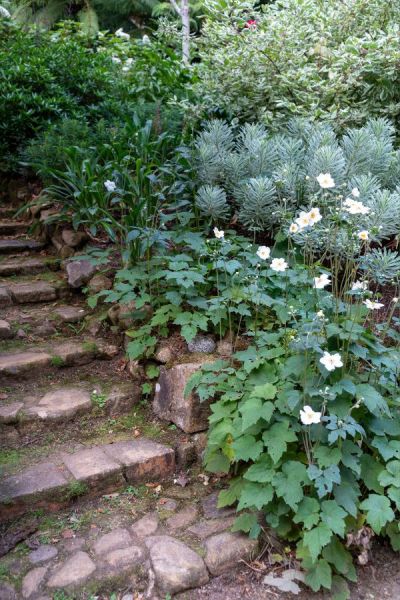
Check where sun and shade falls in your sloping garden. The shady end of this sloping border is nearest the house. It’s planted up with euphorbia, Japanese anemone and other shade lovers. In fact, shady sloping borders are easier to plant than sunny ones, according to Lesley, because shade loving plants are less likely to lean out towards the sun.
Staking is very important in a sloping garden
Lesley has discovered that it’s vital to stake and support plants growing in a sloping bed.
Her main herbaceous border is South-facing, but they are in Australia, so that is equivalent to North-facing in the UK and the US. ‘However, it’s not completely south-facing – it’s at an angle, so the plants can grow towards the sun, as if they were leaning out at an angle,’ she says.
In our post on shady garden planting, horticultural expert Stephen Ryan, says that plants lean out too far if they’re sun-loving plants which have been planted in too shady a spot. However, this border is quite light and open. Lesley has successfully grown lilies, monardas and cannas, so she is only correcting a small amount of lean.
She uses a variety of supports from single ‘shepherd’s crook’ types and hoops to home-made natural supports made from twigs.
Please note that links to Amazon are affiliate, see disclosure.
She also occasionally even uses a few lengths of fencing to hold very heavy things back. ‘As soon as the first shoots come up in spring, I have to remember how tall some of the perennials get. Then the border looks like an industrial landscape for a few weeks, but soon the plants grow over the supports.’
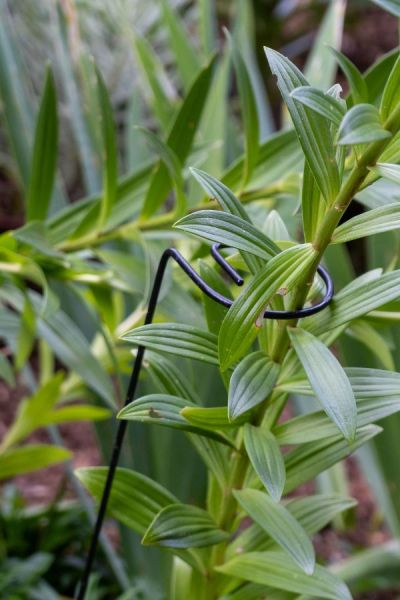
‘Shepherd’s crook’ type plant support in Richard and Lesley’s garden.
Always mulch a sloping garden
While researching sloping gardens, I came across several sites suggesting that you should plant ‘mat-forming plants’. The idea is that the roots help stop water and soil from being washed down the slope.
Lesley hasn’t deliberately planted ‘mat-forming plants’ – she has planted the plants she loves.
‘The most important thing is to mulch a sloping border instead,’ says Lesley. ‘A good mulch of something rough like composted bark helps stop water from running down the hill. The water is more likely to soak into the soil and get to plant roots.’
‘And when you’re planting, do some informal mini-terracing,’ she suggests. There’s a good post on how to plant on a slope here.
In it, Stephen Ryan suggests using a rough mulch, such as Richard and Lesley’s composted bark or straw. It’ll allow rain through but will stay in place. If you want to use compost or garden manure, he adding a layer of the coarser mulch on top to hold it all in place.
Lesley digs a hole which is deeper at the back than the front, so that water doesn’t run straight down but stays in the planting hole. She often also wedges the plant in place with a rock or brick until it’s become established.
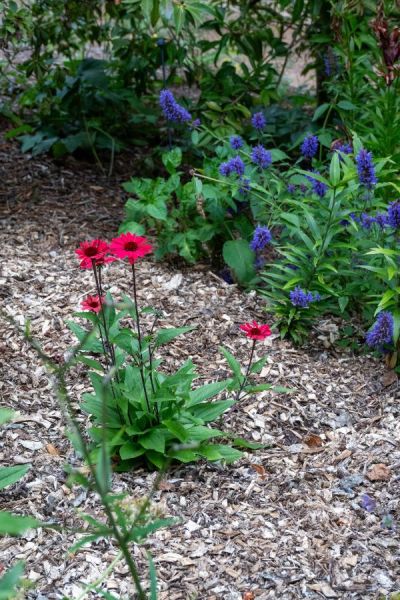
A newly planted plant surrounded by Lesley and Richard’s bark mulch. If you try to water a slope that hasn’t been mulched, and it has dry, exposed soil, then the water will just run off. But water can drain through the mulch and soak into the soil.
Good plants for a sloping garden
People often advise you to grow plants with deep tap roots or mat-forming plants on slopes, but Lesley has grown many bulbs successfully, along with monarda, agastache, roses, euphorbia and agastache. ‘We have critters that eat roses so I plant the roses in the middle of the border in the hope that the possums and deer don’t get to them,’ she says.
It’s more important to choose plants for the amount of shade or sun you have or for your soil type. Provided you mulch well, then you’re not restricted in the palette of plants you grow.
You’re more likely to have problems with drought on a slope. You can find good resilient plant suggestions in 10 beautiful tough perennials for wet or dry summers.
You can also theme a slope. For example, a rock garden makes a good use of a sunny slope. And a stumpery works well for a shady slope.
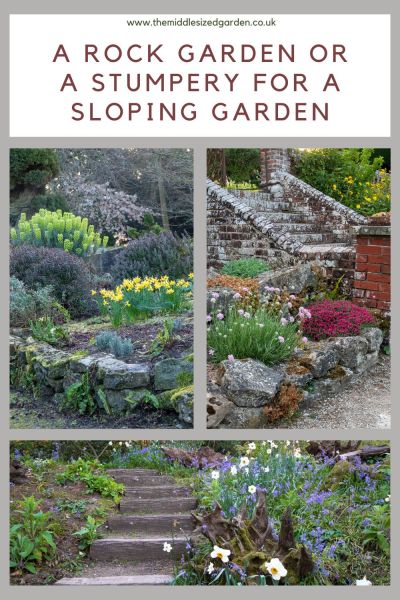
If you’re thinking about planting a sunny slope, rock garden plants would do well. And if it’s a shady slope, then think about woodland plants or even create a stumpery. Rock garden and stumpery both at Doddington Place Gardens.
Landscaping a slope – access is often difficult
Richard points out that access can be a problem in many sloping gardens, because it can be difficult to use big mechanical diggers if the ground slopes too much.
This means that landscaping a sloping garden can be more expensive than it would be otherwise, because much of it has to be done by hand.
Although there was a certain amount of Victorian terracing already in the garden, some slopes had also lost definition.
So Richard taught himself how to make dry stone walls, using YouTube videos.
He also made a giant fruit and vegetable growing cage, terracing most of the interior. There are so many ‘critters’ – deer, wallabies, possums, parrots, rabbits and more – after the produce that it simply isn’t possible to grow fruit and vegetables successfully without protection.
The netted enclosure has three terraced levels, with paving, raised beds and steps. Lesley says that the contrast between the straight lines and relative formality of this area make a good contrast to the more informal sloping borders.
See more of the sloping garden in video
There are some lovely views of the borders, as well as more detail on the netted enclosure in this video.
Pin to remember sloping garden secrets
And do join us. See here for a free weekly email with more gardening tips, ideas and inspiration.
